|
|||||
FlyingRC.net is a
Veteran-Owned site.

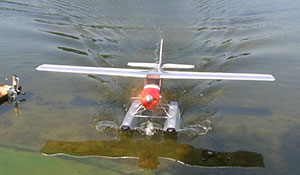 |
| This day starred off great. I was flying off water for the first time and my prized Hangar 9 Valiant was performing perfectly. Then it all went away in seconds. This story is about my search for why the crash happened. Click image to enlarge |
My Hangar 9 Valiant “Autopsy”
The end of one of my favorite airplanes
Text, photos and video by Tom Hintz
Flight videos by Clark Ponthier
Posted – 7-26-2017
When I began running my own web sites, including FlyingRC.net, I promised to be honest about what I am doing, or in this case, what had happened. This “warts and all” web site philosophy means that I must relate the bad with the good, something I have been told repeatedly is cyber-suicide. I am too deep into this style of presenting a web site so, with that in mind, hang on, here comes a really big “wart.”
History Rears Its Ugly Head?
This last weekend I lost my prized Hangar 9 Valiant to what appears to have been a receiver failure. Those of us that were flying RC in the 1970’s and 1980’s, the infamous 72MHz era, know this was not an uncommon occurrence because of the devastating result of someone turning on a transmitter on the same frequency. The limited number of frequencies meant that kind of “shoot-down” happened more frequently as the number of people flying RC ballooned.
Even though I have great confidence in today’s RC radio systems, common sense guarantees that sooner or later an admittedly small number of the millions of RC components manufactured and sold each year will fail. However, we are flying increasingly complex radio systems. With the huge numbers of components being manufactured and sold, it is only logical that an occasional failure will occur.
I am as certain as I can be that such a rare failure is exactly what caused the crash in this story. As soon as the failure began I had that old feeling of the string between me and the plane breaking. I had control, then I didn’t have control. This is a sickening feeling you never forget once it happens to you. Thankfully, those failures are remarkably rare.
Skewing Reality
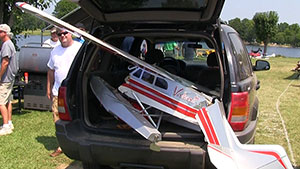 |
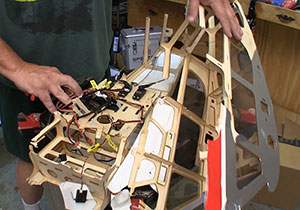 |
| The Valiant went down in a field near the lake. A member of the Smith Lake Flyers took me out in his Jeep (left) to retrieve the plane. Back in the shop (right) I cut the remnants up so I could test the radio with it still installed in this part of the fuselage. Click images to enlarge |
|
One of the more serious problems with the Internet is that it spreads bad news, factual or not, with a speed that is hard to comprehend. Even though most rational people understand that what is said on the Internet has a better chance of being false than factual in real life negative reports of product performance consistently get the most traffic. Part of the problem is that people who are happily flying crisis-free seldom feel the need to broadcast that on line. The result is a false reality that has nothing to do with reality.
Unique Video
The major reason I decided to generate this story is the unique video captured by FlyingRC.net cameraman Clark Ponthier. Clark was shooting footage for the Hangar 9 Quarter-Scale Floats Review when the story changed in real time in his viewfinder. Clark continued to shoot, including the aftermath, which provided the footage we see in this story. The Hangar 9 Valiant went out of camera view behind some trees before hitting the ground but we can clearly see the onset of the gyrations that took it to that end.
Normal then Not Normal
I have lots of flying hours on the Hangar 9 Valiant prior to this incident. Nothing in all of that flying hinted that a problem was occurring or about to. Even the flight before the crash showed no odd tendencies even though I was watching for them intently because of this being the first time I flew the plane with the Hangar 9 Quarter-Scale Floats on it.
After taking off and circling back around the lake I had the Hangar 9 Valiant in a right bank to fly down the “runway” on the lake. Without warning the Hangar 9 Valiant tail began jerking to both sides in response to what appeared to be random control surface deflections. I announced that I had lost control and continued to fight it, to see if I could find one control surface that was working but the Hangar 9 Valiant was having none of that.
During the fight for control the Hangar 9 Valiant started getting closer to the flight line and the long row of cars and people behind me. I again announced that I had no control but added a loud “heads up” this time. Now I wasn’t trying to fly the Hangar 9 Valiant out of this but rather find a way to put it down anywhere the people were not. I have an on board engine kill operated by the Trainer button on my DX 9 transmitter and was pressing that down harder and harder while I continued to work the sticks trying to influence the Hangar 9 Valiant’s path.
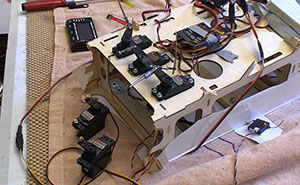 |
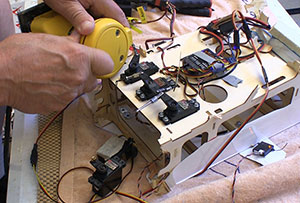 |
| Cutting the radio tray out of the fuse (left) made it much easier to test everything in its original configuration in the plane. To check for vibration issues I held a vibrating sander (right) against the side of he remaining airframe. Nothing twitched at all. Click images to enlarge |
|
After what seemed like a half hour fighting for control (more like 7 seconds in real time) of the Hangar 9 Valiant it went down behind a row of trees at the end of the lake. I hated losing one of my best planes but at the same time was thankful it went down away from everyone. Now I had to go get a busted up giant scale plane.
The Wreckage
Because the winding lake was between us and the downed Hangar 9 Valiant getting to it was looking way more complicated than I initially thought. This all happened at one of the annual Float Fly’s put on by the Smith Lake Flyers, another local AMA club. (See Resources below for a link to their web site) It turns out that I couldn’t have chosen a better place to crash.
One of the Smith Lake Flyers members came over and offered to take me out to get the Hangar 9 Valiant in his Jeep. He unhooked his trailer and we went out to the main road, down a side road and then out across a field to get to the Hangar 9 Valiant. I can’t adequately describe how much this volunteered help simplified recovering the Hangar 9 Valiant. I have been to Fun Fly’s at the Smith Lake Flyers grass field and always enjoyed that. This bit of adversity showed me that they remain a fun, good natured group of people to fly with.
The Hangar 9 Valiant was sitting upright in the field. I have this “last resort” effort to minimize a crash by holding the sticks in what can loosely be described as an “Elevator”. My plan is to keep the downward speed as low as I can. Since the Hangar 9 Valiant went behind trees I was unable to see what was going on so just held the sticks in that configuration until I heard what I thought to be the impact.
Apparently, the Hangar 9 Valiant had more or less belly-flopped on the floats. Both suffered a good amount of damage as did the structure that connected them to the airframe. The belly-flop theory was further supported by the nose snapping off ahead of the floats with no damage to the prop, spinner and just a little damage to cowl. My DLE40 Twin and its mufflers appeared to be just fine. No dirt or scuffing on the spinner further suggested that the engine was fine.
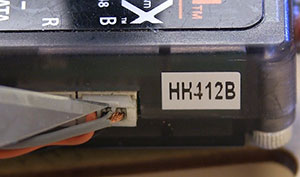 |
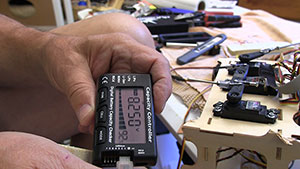 |
| I found this frayed satellite cable (left) but cold not make that influence the radio. It got tossed out anyway. I checked the battery packs (right) and found both to be well over 90-percent of their volume. No problem there either. Click images to enlarge |
|
The tail section had also snapped off behind the floats. One wing tip was crushed a little and the aluminum wing tube was hopelessly bent with both ends downward, further supporting the belly-flop theory.
The structure surrounding the electronics was intact, the power remained on and the servos still active. The fellow helping me said he had a data logger back at his trailer so we left the power on and unceremoniously stuffed the Hangar 9 Valiant remains in the back of his Jeep. The data logger would later show nothing. The entries other than 8.4V of remaining battery power (3S LiPo packs) were zeroed out suggesting that the power had cycled off and back on at least once, not unexpected in a crash.
Checking the System
Back in the shop I cut away the structure surrounding the electronics platform. I plugged the batteries back into the system and turned it on. That was really all it took to diagnose part of the problem. The left elevator servo was locked out at full travel. I shut the system off, moved the left elevator servo back to center and turned the radio back on. Once again, the servo went to full travel and buzzed. I tried other servos in that Aux2 port and they all reacted the same way, going to full travel and staying there. I also plugged the original left elevator servo into other ports and it worked in all of them. This was easy, the receiver had lost the Aux2 channel.
I also found a frayed satellite receiver cable but could not cause any twitching of the radio by moving that cable around. I still took it out and tossed it. All of the servos were tested on my servo tester and all seemed to be fine, no stripped gears or damaged cables. It appears that the belly-flop landing saved a bunch of expensive components.
I have a long-standing post-crash policy of never again flying a crashed receiver or gas tank. It just is not worth it to me to take that kind of chance. The reliability of todays’ radio gear makes flying a new piece less dangerous to me than re-using a crashed one. I also will not sell or give away components that I think are questionable. I just do not want to take that chance or to pass the problem on to someone else. That’s just me, you do what you feel best about.
Video Tutor |
Conclusion
Losing my Hangar 9 Valiant sucks big time but this is a reality of putting model radio controlled airplanes in the air. It doesn’t happen nearly as often as it used to in the 72MHz era but it still does happen. To me, there is very little I can do other than accept this whole thing as a thankfully rare part of the hobby and move on. I have not lost confidence in my Spektrum equipment even though declaring everything made by them to be junk is kind of stylish in the modern cyber-world. In the real world, I got one of the few dud receivers. I got over it, others can gnash their teeth or whatever is popular in the forums right now. I want to go flying, someday with a new Hangar 9 Valiant, hopefully on floats a couple times per year.
Resources
Smith Lake Flyers web site – Click Here
Have a comment on this story? –Email Me!
All Flyingrc.net written, photographic and drawn materials are property of and copyright by Tom Hintz and Flyingrc.net 2013-2020 Materials cannot be used in any way without the prior written permission of the owner.
Privacy Statement


